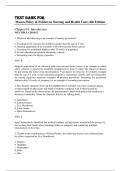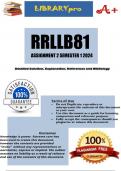Test Bank For
Mason Policy & Politics in Nursing and Health Care, 8th Edition
Chapter 01: Introduction
MULTIPLE CHOICE
M
1. Which of the following is an example of tertiary prevention?
a. Vaccination for rotavirus for children younger than the age of 1 year
ED
b. Surgical amputation of an extremity with osteosarcoma (bone cancer)
c. Screening for gestational diabetes after 24 weeks of pregnancy
d. Sexual education program in elementary schools
e. Increasing taxes for buying cigarettes
C
ANS: B
Surgical amputation of an extremity with osteosarcoma (bone cancer) is an example in which
O
when a disease is present the treatment (amputation) is done to reduce the impact of disease
by preventing the tumor from dissemination. Vaccination for rotavirus for children younger
than the age of 1 year, sexual education program in elementary schools, and increasing taxes
for buying cigarettes represent examples of primary prevention. Screening for gestational
N
diabetes after 24 weeks of pregnancy is an example of secondary prevention.
2. This historic character observed that childbed fever mortality was more common among
N
women treated by physicians and medical students compared with women treated by
midwives. Based on his observations, he implemented a hand wash policy that resulted in a
decrease in mortality. Name the character that we are talking about.
O
a. John Snow
b. Edward Jenner
IS
c. D.A. Henderson
d. Leon Gordis
e. Ignaz Semmelweis
SE
ANS: E
Ignaz Semmelweis identified that medical students and physicians transmitted the disease by
not washing their hands after examining bodies at autopsies and conducting multiple
examinations in the clinic.
U
3. Thanks to the contributions of Edward Jenner, the following disease was eradicated later
by efforts organized by D.A. Henderson:
R
a. Cholera
b. Smallpox
c. Chickenpox
d. Polio
e. Zika
, Test Bank 1-2
ANS: B
Smallpox was eradicated in 1980. Edward Jenner vaccinated James Phipps in 1796 against
smallpox. Almost 200 years later, the World Health Organization (WHO) commissioned
D.A. Henderson to lead the efforts to eradicate the disease.
M
4. Over the past century, a marked decline in the mortality rates of many infectious diseases
has been observed. Which of the following is the most likely reason for the observed decline
in mortality rates from common infectious diseases?
ED
a. Development of penicillin
b. Development of insulin
c. Development of vaccines
d. Improvement in social conditions
e. Worse sanitation and unsafe water
C
ANS: D
O
Although medical treatments potentially helped in the decrease of infectious diseases, the
advancement in social conditions played a major role. These improvements include better
sanitation, safe disposal of waste, better nutrition, and improvement in housing conditions.
N
N
Chapter 02: The Dynamics of Disease Transmission
O
Test Bank
MULTIPLE CHOICE
IS
1. Which term most accurately describes the following definition? “The occurrence in a
community or region of cases of an illness, specific health-related behavior, or other health-
related events clearly in excess of normal expectancy.” [Porta M, ed. A Dictionary of
SE
Epidemiology. New York: Oxford University Press; 2014.]
a. Endemic
b. Epidemic
c. Pandemic
d. Attack rate
U
e. Incubation period
ANS: B
R
An epidemic is the occurrence of health-related events in a community or region, in clear
excess of normal expectation. Endemic is not true because it is defined as the constant
occurrence of a disease, disorder, or noxious infectious agent in a geographic area or
population group. Pandemic is not true because it is defined as an epidemic occurring over a
very wide area, crossing international boundaries, and usually affecting a large number of
Copyright © 2020 by Elsevier, Inc. All rights reserved.
, Test Bank 1-3
people. Attack rate is not true because it is defined as number of people at risk in whom a
certain illness develops over total number of people at risk. Incubation period is not true
because it is the interval from receipt of infection to the time of onset of clinical illness (the
onset of recognizable symptoms).
2. What is the most accurate definition of the incubation period (of an infectious disease)?
M
a. The time of onset of clinical illness or the onset of recognizable symptoms
b. The interval from receipt of infection to the time of onset of clinical illness (the onset of
recognizable symptoms)
c. The time of invasion by an infectious agent
ED
d. The time between initiation of infection and first shedding or excretion of the agent
e. The period between exposure and the onset of infectiousness
ANS: B
C
The incubation period is defined as the interval from receipt of infection to the time of onset
of clinical illness (the onset of recognizable symptoms); in other words, the time between the
moment of developing symptoms and the moment of invasion by an infectious agent. “The
O
time of onset of clinical illness or the onset of recognizable symptoms” is not true as it
corresponds to “time of onset.” “The time of invasion by an infectious agent” is not true as it
corresponds to “time of infection.” “The time between initiation of infection and first
shedding or excretion of the agent” and “The period between exposure and the onset of
N
infectiousness” are not true as they correspond to the latent period. (The latent period is
focusing on the onset of infectiousness, but the incubation period is focusing on the onset of
N
the symptom.)
3. There was a food poisoning outbreak on April 1, 2018, at the City Z Food Safety
O
Conference. There were 1,000 people registered for the conference with luncheon, 100
volunteers to host attendees, and 50 people who served the luncheon during the conference.
Except for 50 people who served the food, all of the participants and volunteers ate the food
from the luncheon at the conference on April 1, 2018. Based only on the information given in
IS
this question, how many people are at risk in this food poisoning outbreak?
a. 1,000
SE
b. 1,100
c. 1,150
d. 150
e. 50
ANS: B
U
People at risk in this outbreak are people who were exposed to the food at the conference.
Even though 1,150 people were at the conference, 50 people who served the food did not eat
R
the food. Therefore we have to exclude those 50 people.
4. There was a food poisoning outbreak on April 1, 2018, at the City Z Food Safety
Conference. There were 1,000 people registered for the conference with luncheon, 100
volunteers to host attendees, and 50 people who served the luncheon during the conference.
Except for 50 people who served the food, all of the participants and volunteers ate the food
Copyright © 2020 by Elsevier, Inc. All rights reserved.
, Test Bank 1-4
from the luncheon at the conference on April 1, 2018. After an initial outbreak of food
poisoning is reported, an epidemiologist sends surveys to all people at risk to investigate the
cause. However, only 900 people among those at risk answer the survey. After analysis of
900 survey results, the epidemiologist concludes that the most suspected foods in the
outbreak are pepperoni pizza and meatball spaghetti. What is the overall attack rate for those
who ate meatball spaghetti? Use the following table to answer the question.
Summary of Survey Responses
M
Number of people who Number of people who ate the
developed the case definition food
symptoms
ED
Pepperoni pizza only 113 275
Meatball spaghetti only 62 375
Both pepperoni pizza and 57 150
meatball spaghetti
C
Neither of pepperoni pizza or 10 100
meatball spaghetti
O
a. 41%
N
b. 38%
c. 27%
d. 40%
N
e. 23%
ANS: E
O
To calculate the food-specific attack rate, we need to define how many people are exposed to
the specific food and how many people develop the symptoms in the case definition. In this
question, we are asking about “overall” attack rate in those people who ate meatball
IS
spaghetti, so we have to add “meatball spaghetti only” and “both pepperoni pizza and
meatball spaghetti” to get the overall rate. Which is 525 (375 plus 150), who are at risk of
exposure, and 119 (62 plus 57), who developed the symptoms, corresponding to 23% of
SE
attack rate.
5. There was a food poisoning outbreak on April 1, 2018, at the City Z Food Safety
Conference. There were 1,000 people registered for the conference with luncheon, 100
volunteers to host attendees, and 50 people who served the luncheon during the conference.
Except for 50 people who served the food, all of the participants and volunteers ate the food
U
from the luncheon at the conference on April 1, 2018. After an initial outbreak of food
poisoning is reported, an epidemiologist sends surveys to all people at risk to investigate the
cause. However, only 900 people among those at risk answer the survey. After analysis of
R
900 survey results, the epidemiologist concludes that the most suspected foods in the
outbreak are pepperoni pizza and meatball spaghetti. What is the most suspected food for
food poisoning after cross-tabulation? Use the following table to answer the question.
Summary of Survey Responses
Number of people who Number of people who ate the
Copyright © 2020 by Elsevier, Inc. All rights reserved.





